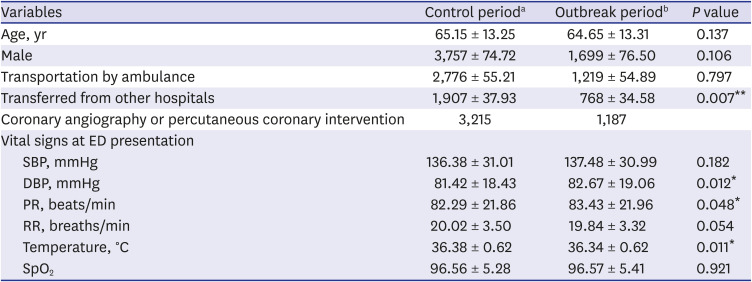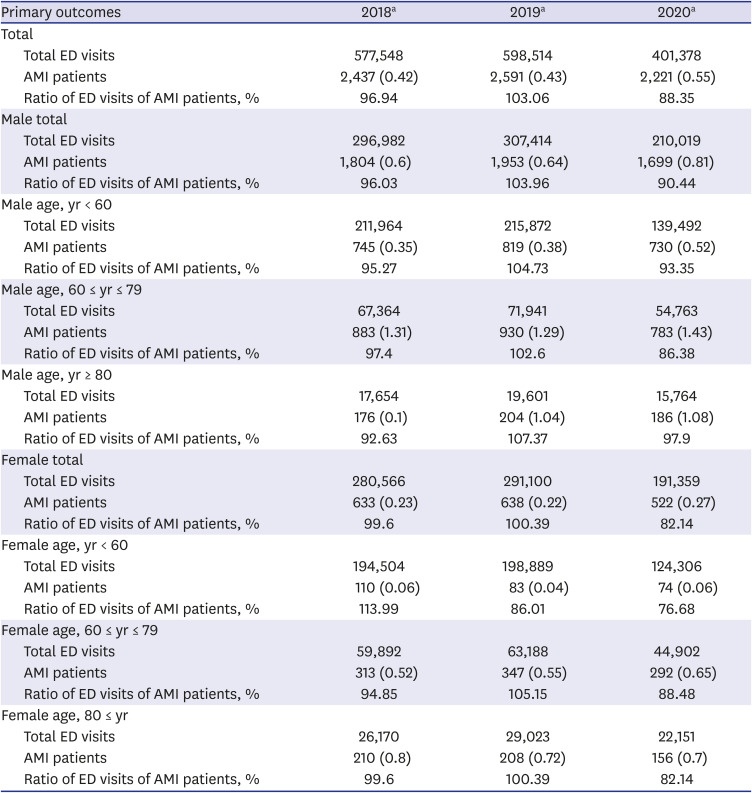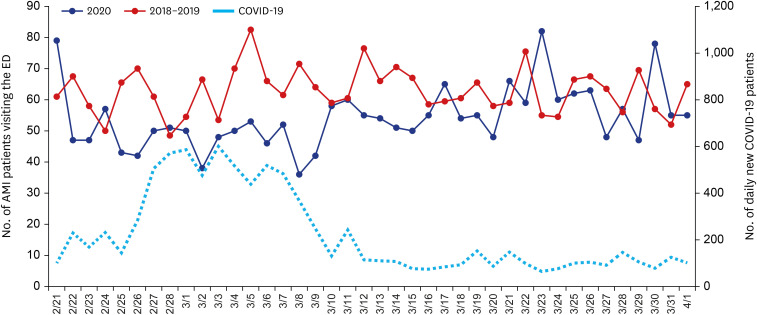INTRODUCTION
Coronavirus disease 2019 (COVID-19) was first reported in China in December, 2019. It then spread globally, following which the World Health Organization declared COVID-19 a pandemic on March 12, 2020. As of November 29, 2020, there have been over 61.8 million cases and over 1.4 million deaths reported globally.
1 In Korea, the first case of COVID-19 was reported on January 20, 2020, and as of December 8, there have been 38,755 confirmed cases of COVID-19 with approximately 552 deaths.
2
Such epidemics influence various aspects of daily living and cause changes in the pattern and number of medical visits. These changes were observed during the severe acute respiratory syndrome (SARS) and Middle East respiratory syndrome (MERS) outbreaks; relevant findings have been reported. During the SARS outbreak, there was a decrease in the total number of emergency department (ED) visits, primarily of patients presenting with respiratory symptoms. Some studies reported that changes in healthcare utilization differed across age groups, while other studies reported a reduction in the number of ED visits alone.
34
As many studies investigated the changes in trends of ED visits during the MERS outbreak, it has been reported that South Korea had similar experiences during the MERS epidemic in 2015. While the total number of ED visits decreased, the change was more evident for pediatric and non-emergency cases.
5 Another study reported a similar finding wherein the total number of ED visits decreased with marked changes with respect to non-emergency cases; however, the same study reported that there were no grave changes observed in regard to severe illnesses and ED mortality.
6 Additionally, a study reported an increasing trend in ED visits owing to fever.
7
Studies are now reporting that COVID-19 is also causing a shift in healthcare utilization. A study conducted in the United States that retrospectively analyzed data from the National Center for Immunization and Respiratory Diseases stated that a decrease in the total number of ED visits raised concerns regarding severely ill patients not being able to visit hospitals.
8
In Korea, a study reported a decrease in the number of outpatient and ED visits by patients with spinal disorders; however, no changes were observed in the number of surgeries performed.
9 While another study reported decreased healthcare utilization in patients with rheumatoid arthritis.
10
Acute myocardial infarction (AMI) is a critical disease with high rates of mortality and morbidity, and this condition requires timely treatment. Therefore, an immediate ED visit is required; however, no domestic studies have reported the effect of COVID-19 on ED visits by patients with AMI.
We investigated the effect of the COVID-19 pandemic on ED visits due to AMI and the prognosis of myocardial infarction when compared with those during the control period.
METHODS
Study design and data source
This was a nationwide, retrospective study. The registry data of the National Emergency Department Information System (NEDIS) managed by the National Emergency Medical Center (NEMC) were used. NEDIS is a prospective collection of data on the demographic and baseline clinical characteristics of patients from all emergency healthcare facilities. Since 2016, all emergency healthcare facilities in Korea have been required to adopt the NEDIS-based registration system that is utilized in the evaluation of emergency healthcare facilities and payment systems. The number of emergency healthcare facilities participating in the NEDIS registry is 408 out of 413 in 2016(98.8%), 413 out of 416 in 2017(99.3%), 399 out of 401 in 2018(99.5%), 401 out of 402(99.8%) in 2019, and 403 out of 403(100%) in 2020. Detailed information about types and numbers of facilities was presented in
Supplementary Table 1. Healthcare providers and administrators in regional emergency medical centers are required to input data related to the NEDIS system and to hire coordinators from the NEMC to be in charge of hospital-based monitoring and feedback.
The registry data consist of approximately 60 items that can be divided according to the following factors: demographics including age, gender, identification number, address, type of medical insurance; baseline characteristics including symptom onset time, route of visit, mode of visit, ED visit time, ED discharge time, chief complaint, KTAS level, ICD-10 based diagnosis, vital signs at presentation, and ED disposition.
1112
Study period
The period between February 21, 2020, and April 1, 2020, which was amidst the COVID-19 outbreak, was defined as the ‘outbreak period,’ and the same time periods during 2018 and 2019 were defined as the ‘control period’ to compare patients during the two periods. The start date of the outbreak period was defined as the first day when the number of patients occurred more than 100 per day. The end date of the outbreak period is defined as the first date on which the daily number of patients is maintained at or below 100 until one week after the end date. The dates corresponding to the criteria were from February 21 to April 1, 2020 in Korea.
Data collection
In this study, we obtained the following codes: date of visit, time of visit, age group, sex, date of onset, time of onset, route of visit, mode of visit, systolic blood pressure (SBP) at visit, diastolic blood pressure (DBP) at visit, pulse rate at visit, breathing rate at visit, body temperature at visit, oxygen saturation at visit, outcome of emergency care, date of discharge, time of discharge, post-admission outcomes, diagnosis code at discharge, diagnosis category code at discharge, procedural code at ED, and procedural code after admission from the NEDIS data for analysis.
Operational definitions of AMI patients
Health insurance data or NEDIS data are collected for claims or emergency medical system monitoring purposes and thus do not contain detailed clinical information such as clinical data, which may undermine the accuracy of the study. To address this shortcoming, operational definitions of each disease should be utilized, as they will reduce potential overestimations or underestimations.
13 According to Ahn,
13 a more stable incidence estimation can be obtained using an operational definition that simultaneously utilizes disease codes and procedural codes when computing the incidence of AMI, which is less influenced by other conditions and changes in the claims-related system.
14
In the present study, patients with ICD code I21 (AMI) as the primary or secondary diagnosis at discharge from the ED or hospital were selected from the NEDIS data. Regarding the procedural code, patients given a code for AMI-related procedures as the procedure in the ED or after admission were selected from the NEDIS data. The AMI-related procedure codes were determined based on a previous report.
13 Detailed information about procedure codes was presented in
Supplementary Table 2.
Patients who met both the criteria of the disease code and procedure code were defined as patients with AMI.
Primary outcome
The primary outcome was defined as the number of patients admitted to the ED due to AMI during the control and outbreak periods. Further, to assess the reduction in ED visits, the percentage of ED visits in 2020 compared with those in the same periods in 2018 and 2019 was calculated as follows:
Secondary outcome
In addition to the primary outcome, the following three outcomes were analyzed as secondary outcomes: time from symptom onset to ED visit, length of ED stay, and mortality within 30 days of admission.
Statistical analysis
Nominal variables consisting of two categories were analyzed using the Pearson χ2 test or Fisher's exact test, and the results are expressed as frequencies and percentages. For continuous variables, we determined normality based on the shape of the graph, the comparison between the mean and median values, skewness, and kurtosis. Variables with normal distribution were analyzed using Student's t-test and expressed as means and standard deviations. Skewed variables were tested using the Wilcoxon rank-sum test and expressed as the median and interquartile range. Data analysis was conducted using SAS (version 9.4; SAS Institute, Inc., Cary, NC, USA).
Ethics statement
The present study protocol was reviewed and approved by the Institutional Review Board of the NEMC (No.NMC-2007-026). The requirement of informed consent was waived owing to the retrospective nature of the study.
DISCUSSION
This is the first nationwide study to analyze the impact of the COVID-19 pandemic on ED visits of patients with AMI. There have been multicenter studies that have investigated the effects of COVID-19 on healthcare utilization by patients with AMI or other circulatory diseases in other countries; however, none of the studies analyzed data from all emergency healthcare facilities in a country. In Korea, one study examined the effects of COVID-19 on outpatient department visits by patients with other diseases
10; however, no study has reported its impact on the frequency of ED visits by AMI patients.
Changes in patterns of visiting the ED have been reported during previous outbreaks of SARS and MERS. Heiber and Lou
3 reported that the number of ED visits decreased by about 21% during the SARS outbreak when compared with that during the same period in the two preceding years, with most marked changes observed among cases involving infants and toddlers (0–3 years); in contrast, ED visits by teenagers and adults (13–64 years) owing to respiratory diseases increased. Chen et al.
4 reported that the percentage of patients in an urban ED in Taiwan decreased by 33.4% during the SARS outbreak.
Such reductions in ED visits have also been observed during the MERS outbreak in Korea. A study by Paek et al.
5 revealed a decrease in the number of patients with non-urgent conditions and length of ED stay in one tertiary referral hospital, with the changes being more evident among cases involving children than adults. Lee et al.
6 in their analysis of data of the National Health Information Database, reported that while the number of visits owing to non-urgent diseases markedly decreased, there were no notable changes observed in the number of visits owing to severe diseases and 7-day mortality after ED admission.
Boserup et al.
8 raised concerns regarding reports showing a decrease in the total number of ED visits citing fear of contracting COVID-19 and patients' neglect of emergency symptoms. Multiple studies have reported a reduction in the number of patients with AMI visiting the ED during the COVID-19 outbreak.
151617 Although this was a preliminary analysis, a study reported an increased time component of ST-segment elevation myocardial infarction care (symptom onset to first medical contact, door to device, catheterization laboratory arrival to device).
18
Previous studies investigating the impact of the COVID-19 on ED visits in patients with myocardial infarction have shown various results. Studies conducted in the U.S. and Italy reported a clear decrease in patients with AMI visiting the emergency room, but no change in Taiwan.
171920
In the present study, the total number of ED visits and ED visits by AMI patients were observed to be markedly decreased during the COVID-19 outbreak. The reason for the decrease in the number of AMI patients visiting the emergency room is estimated to be a result of two factors. First, the incidence of AMI patients remains unchanged, and the number of patients visiting the ED may decrease due to various reasons. Mafham et al.
21 reported that the reduced number of AMI admissions is likely to have resulted in increases in out-of-hospital deaths and long-term complications of myocardial infarction. It is estimated that the following reasons are why patients hesitate to visit the ED. On the policy front, implementation of policies such as social distancing and quarantine to control the COVID-19 outbreak could possibly influence the comprehensive healthcare system for the treatment of AMI. From a patients' perspective, multiple factors may hinder the utilization of emergency care, these include misinterpreting the symptoms of myocardial infarction, such as chest discomfort and dyspnea, as symptoms of respiratory infection, fear of acquiring COVID-19, fear of not receiving proper treatment due to healthcare providers' fatigue or lack of resources, and efforts taken to not further burden the already overloaded emergency medical system, such as 119. Further, the restricted emergency medical system and shortage of quarantine facilities may stymie patient's ED visits.
1617 Given that women under the age of 60 have the longest time from symptom onset to ED visit and the lowest ratio of ED visits, one may think they have been most affected by the factors that hinder ED visits.
Second, although it is likely that the reduced number of AMI patients presenting to the ED is due to reduced ED visits by patients, as opposed to an actual reduction in the number of patients with AMI, the possibility that this may actually indicate a reduction in the incidence of AMI should be taken into account. There exists reported theoretical evidence supporting the rationale that COVID-19 may cause a decrease in the incidence of AMI, as a result of lifestyle changes in which people avoid physically straining exercise and reduce atmospheric contamination; although this has not been substantiated.
22 After this period, we need to analyze trends of sudden cardiac arrest, cardiogenic shock, and cause of out of hospital cardiac arrest to distinguish the preceding two aspects.
Two aspects of Emergency Department Length Of Stay (EDLOS) reduction can be considered: During the epidemic, many infectious personnel and resources were required, but due to the decrease in emergency room patients and inpatients, other resources were more sufficient than usual, which would have enabled rapid treatment and hospitalization. In other respects, EDLOS may be a statistical coincidence due to an increase in the number of samples, given that there are no statistically significant groups in the subgroup analysis.
Although not statistically significant, the increase in mortality within 30 days of admission may be due to accidental findings or to infection preventive guidelines such as use of personal protective equipment before interventions begin.
AMI is associated with high mortality and morbidity and failing to receive timely treatment is highly likely to exacerbate the clinical progress, such as increase the risk of death and disabilities, highlighting the importance of a well-managed comprehensive care system. Healthcare providers and emergency medical systems must strive to maintain a comprehensive care system for AMI in strict compliance with disinfection measures to prevent any obstacles to ED visits by AMI patients during the COVID-19 pandemic.
This study had several limitations. First, this study utilized the NEDIS data, which are more like claims data, as opposed to in-depth hospital medical record review; therefore, there may be errors in the final diagnosis. Second, there is a possibility of recall bias due to the retrospective nature of the study. Third, we conducted this study under the premise that no other factors affected ED visits during the outbreak period. Thus, we cannot eliminate the possibility of factors other than COVID-19 affecting the study results during the outbreak period.
In conclusion, the COVID-19 outbreak has caused a reduction in ED visits by AMI patients, which is expected to influence the clinical course of the patients. Accordingly, the healthcare staff and emergency medicine personnel should work towards eliminating hurdles due to the COVID-19 pandemic for ensuring timely treatment of patients with AMI.







 PDF
PDF Citation
Citation Print
Print






 XML Download
XML Download